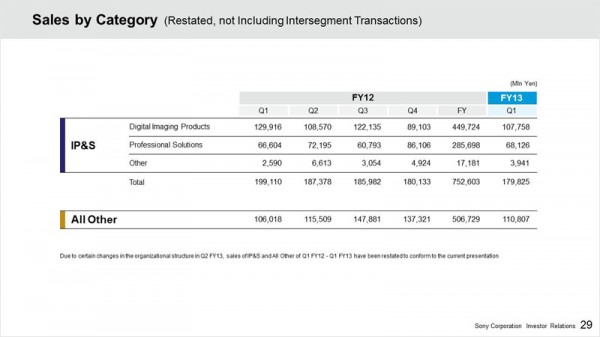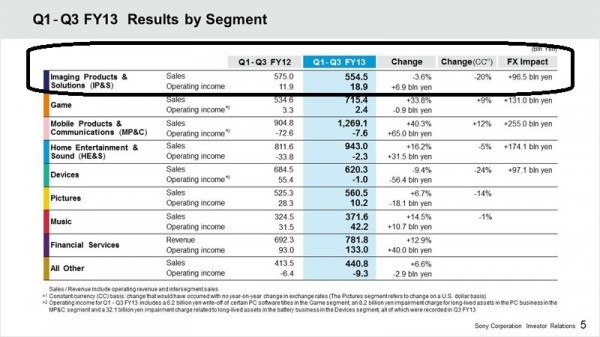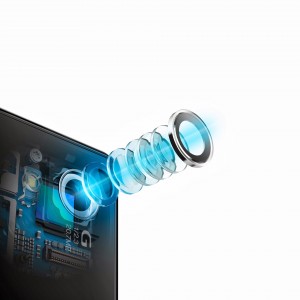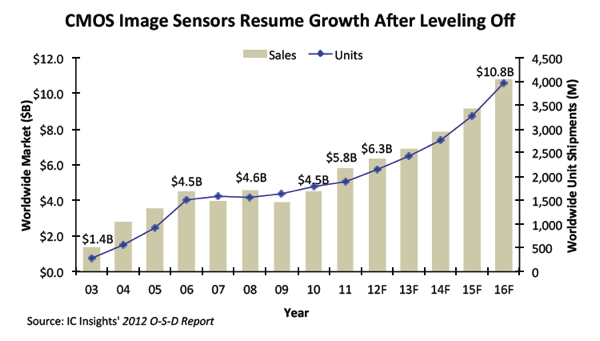
Charity Lemonade Stand with Hugh Hefner
Now that we are just a few days away from the end of Sony’s financial year, the company has reported a 16% rise in sales of image sensors compared with 2012. This news should help the company maintain it’s pole position in the lucrative smartphone image sensor market. Sony has twice purchased more factories to boost CMOS sensor production as currently demand is expected to outstrip supply within two years. The Japanese electronics giant has benefited from the cultural rise of the ‘selfie’ along with a flourishing global smartphone market.
But this is more than just a case of being in the right business at the right time. Smartphone sales may be thriving, but not all manufacturers are benefiting. In just a few years, Sony has completely changed it’s strategy regarding access to their coveted image sensors. Under the leadership of the previous CEO Sir Howard Stringer, the plan was to limit competitors access to the technology. Now under CEO Kaz Hirai, any company looking to supply their phones with Sony’s image sensors are absolutely welcome, it seems. It’s an overhaul from being ‘alone in the sandpit’ to ‘selling lemonade on a hot day’.
Rival Samsung chose Sony to supply the Galaxy S4 with Japanese tech but has now started taking this production in-house. This presents a formidable new competitor in the CMOS market. How did Sony get to the top of this market and what is Sony’s plan to stay dominant?
Current market situation
Where is Sony now? How well is the imaging division performing?
Imaging joins Game and Mobile as the company’s triple pillar of growth and profit as it continues to transform into a more competitive entity. The company celebrated 6m PS4 console sales at the start of March, having already shot past its full year goal of 5m units a month ago. Xperia smartphone sales are projected to come in at 40m units, up from 33m the year before. Imaging completes the three high growth/profit divisions with the 16% sales rise this year.
How are Sony’s image sensors performing compared with previous quarters? This is the latest snapshot of unit sales in the imaging division available in the Q3 FY13 Consolidated Financial Results. It provides more specific information on how different segments within Imaging have been performing. We can see that the main split in between digital imaging products and professional solutions with digital imaging leading the way. Profit based on sales is in the next chart.
Production capacity for image sensors is being increased in response to strong demand for image sensors for smartphones and tablets…working together in both hardware and software to create and promote 4K…
Sony management comments on the Q4 from Q3 results.

Comparing Q1-Q3 for 2013 with 2012, despite a slight dip in sales, operating income has been on the rise.

![]()
The benefits of a change in strategy
Sony has changed it’s strategy regarding boosting sales and market share of its image sensors in recent years. You may remember the previous Sony Corp. CEO Sir Howard Stringer rejecting the idea of making the illustrious sensors available to competitors. Playing the exclusive-game might work better as a strategy for a company with a much more substantial global market share, and even then it may not be the best policy.
That wasn’t the first time that a Sony company made an infamous strategy decision. Then owning half of the venture, you may remember Sony Ericsson president Bert Nordberg mentioning that the company turned down an offer from Google to build the original Nexus One. That was at a time when SE was suffering a $1 billion annual loss, while the HTC brand became synonymous with Android, thanks to its early and high-profile start with Google. But Sony seems to have learned from this and moved on.

Now under current Corp. CEO Kaz Hirai, Sony has been intentionally trying to get it’s sensors in as many rival’s smartphones as possible, delivering a superior camera experience than the partners could manufacture themselves. We know from product tear-downs and company disclosures that Sony image sensors power Apple’s iPhone 5S and Samsung’s Galaxy S4 smartphones. The volume of sales with these two deals alone has provided Sony with a lucrative client list, broader market share for sensors and added value to the Sony name, which as we know has been traditionally been associated with technological excellence and reliability. How about a valuable revenue stream too?
You can view Apple’s supplier list 2014 here. (This link produces a browser security message, despite coming clearly from the Apple domain. It immediately downloads the PDF supplier list from Apple.)
Maintaining Pole Position
Samsung worked with Sony for the Galaxy S4, but for the S5, the South-Korean company decided to produce the CMOS sensor itself.

Good news from Cupertino though. Sony Mobile’s business with Apple is prospering. Asia’s Nikkei reports that Sony is currently in talks with Apple to double its supply of CMOS sensors starting from next year. Perhaps the rumours are true: Sony may be about to increase its presence in the iPhone by producing the front camera sensor for the next model too. If consumer demand for higher quality front cameras is increasing, perhaps tablets and wearables will be next Sonys next target?
The president of Sony’s Device division, Yutaka Okamoto spoke to Reuters last week, commenting on Samsung and telling us what they are looking toward next:
Our hope is that wearables are next. We also expect to see increasing demand for sensors used in medical devices, autos, and in agriculture…
Our strength – and Samsung’s – is that we can accumulate expertise on our own production lines…
The fact that Samsung makes their own products on their own line with their own technology, that’s a threat…
Sony has being looking toward production capacity in the future, expecting demand to exceed production capacity by mid-2015. Now Chinese smartphone manufacturers are turning to Sony for high quality image sensors as the domestic market swells. To solve this during a fruitful time for CMOS negotiations with other companies, Sony agreed to buy a factory from Renesas Electronics in January. This comes just months after buying more CMOS production capacity: Tsuruoka Factory to “reinforce production capacity of CMOS sensors”.
The future looks bright for Sony in this market. Market research company IC Insights, Inc. predicts the CMOS market to start breaking sales records in the coming years. They expect a 13% annual growth rate in the market to 2016. As Sony commented on the PS4 sales, it has been a matter of every unit produced is sold before leaving the production line, it seems CMOS sensors are following suit.
Discuss:
Should Sony limit access to it’s camera tech. if it gains captures high market share, or keep supplying rivals?


You must be logged in to post a comment.